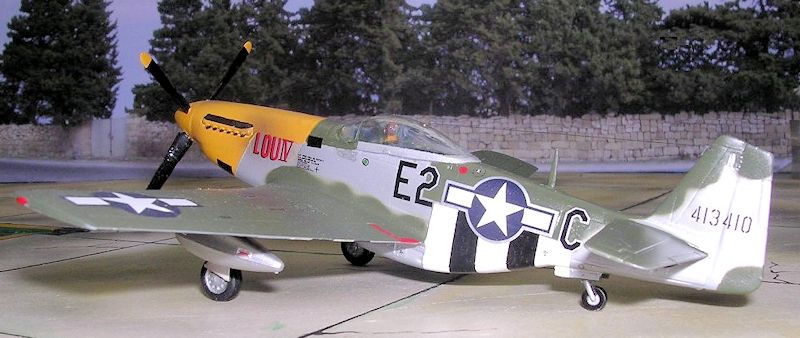
| HISTORY |
| KIT #: | ? |
| PRICE: | $ |
| DECALS: | Two/ options |
| REVIEWER: | Carmel J. Attard |
| NOTES: |

| HISTORY |
During the later part of
WWII the historic yellow nose Mustangs of 361st
Fighter Group 8th AF, USAAF were
once based at an airfield located in the village of Bottisham, in Cambridgeshire.
Mustangs from this group are lavishly featured on a set of museum class decals,
released by Aero Master to scales of 1/72, 1/48 and later to 1/32 scale. Between
the 30th Nov.1943 up till the 26th
Sep1944 the 361st Fighter Group
conducted air strikes and fighter escort to USAAF bombers flying over Europe,
from their base at Bottisham. Between 10th
of February 1943 to the 12th of
Aug.1944 the Group Commanding officer for the 361st
FG was Col.Thomas JJ Christian Jr. He flew on Mustang P-51D called Lou IV serial
No 413410.
Bottisham is situated
south of the A45 and about 5 miles east of Cambridge. Nowadays the new A45 road
crosses the centre of the airfield. In its origin and with the war starting,
Bottisham consisted of a few tents and training quarters with Tigermoths that
were armed with 25 lbs. bombs for use in the event enemy troops invade UK east
coast and step ashore. The Tigermoths belonged to the 22nd
EFTS for training of pilots. In mid July 1941 the airfield was taken over by
Army C0-operational Command. Nine dispersal sites were built in or around the
village. Bottisham Hall was commandeered and utilized as the Officers' Mess and,
together with temporary buildings erected in the grounds for officers and their
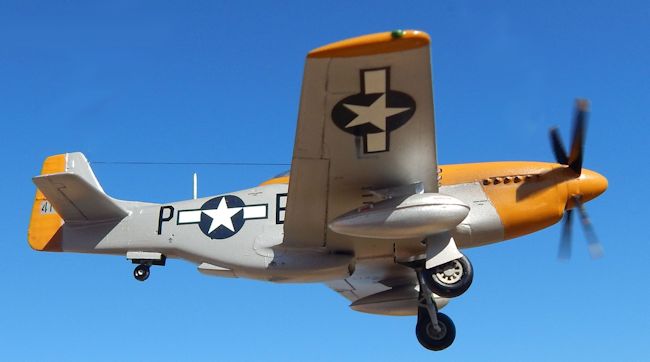 batmen became Site 2. A squash court was also built there, as was a building to
house the Link Trainer, completed in Sept.1941. Site No3, an 'other ranks'
communal site, was situated about 400 yards along Turnbridge Lane and contained
such buildings and the gymnasium and chapel, medical inspection hut, Sergeants'
Mess for 125, NAAFI for 540, Airmen's Mess for 1717, bath house, ration stores
etc etc.
batmen became Site 2. A squash court was also built there, as was a building to
house the Link Trainer, completed in Sept.1941. Site No3, an 'other ranks'
communal site, was situated about 400 yards along Turnbridge Lane and contained
such buildings and the gymnasium and chapel, medical inspection hut, Sergeants'
Mess for 125, NAAFI for 540, Airmen's Mess for 1717, bath house, ration stores
etc etc.
Lysanders of 241
Squadron worked closely with Eastern Command Army units. These were followed by
Allison engine Tomahawks. After they were seen flying in pairs on training
sorties often seen beating up army convoys. On the 15th
March, some of the RAF's first Mustangs arrived for 241 Sq. They were fast and
maneuverable but their performance falling off rapidly above 15,000 feet, thus
causing some disappointment. In May 1942, No 241 Sq moved to Ayr.Tigermoths of
652 Sq arrived in mid June staying until the 31st
of August for training AOP pilots. By the A45 side of the field there were steel
net dispersal areas. These were protected by earth walls with a couple of
blistered hangars, used for maintenance. Concrete huts were later erected in
North East corner that still stand today. On the 15th
of October 1942, lying began of two Sommerfield track runways with the first one
coming into use in July 1942.
Interesting about Bottisham was that on 23-9-42 a
couple of Whitleys brought in two Horsa gliders, which was a prelude for things
to come. On the following November eight Mustangs arrived from Ayr to equip 168
Sq then equipped with Tomahawks. Five Whitleys and a Horsa arrived 11 days
later. Their task was to transport 168 Sq to Odiham for operational deployment.
After they left the airfield was to undergo major alterations. Two runways were
laid and supported by a hangar, 7 blister hangars and 15 concrete hardstanding
and 68 pierced steel mat dispersals. The two metal runways 020 and 090 were 1200
yards and 1435 yards respectively and 100 yards wide.
It was on the 3rd
December 1943 that the airfield was taken over by 361st
Fighter Group with the Republic P47 Thunderbolt. There starting operations on21
st June 1944 conducting a dual role of bomber and ground strafing. P47s wee then
a common sight flying a 4-ship formation. During May same year 361st a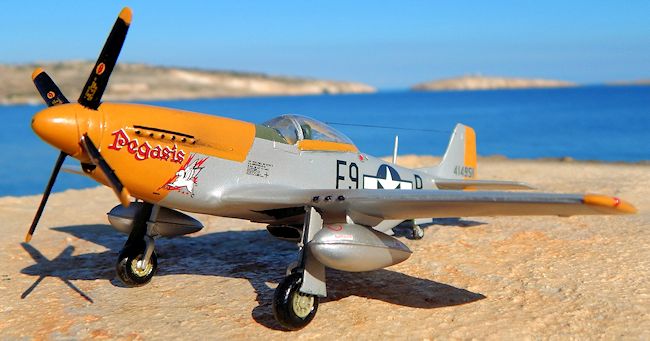 lso began
receiving P-51Ds Mustangs. These Mustangs soon started to display the
White/Black invasion stripes at the time of the D-day. Some were to be seen with
their upper surface painted in a disputable shade of deep blue, others regarded
it as a shade of olive green.
lso began
receiving P-51Ds Mustangs. These Mustangs soon started to display the
White/Black invasion stripes at the time of the D-day. Some were to be seen with
their upper surface painted in a disputable shade of deep blue, others regarded
it as a shade of olive green.
The 361st
Group from Bottisham after converting to Mustangs was credited with a variety of
victories on missions over occupied Europe. This included the destruction of 23
locomotives and damage of two others. On another occasion they broke up a
formation of Me-109s and afterwards strafed an airfield near Oschersleben where
a four plane flight led by Lt. Col Webb netted at least 16 aircraft destroyed
and many others damaged in eight passes over a poorly defended field. On the 6th
November 1944 P-51 Group escorting B24 formations in the Minden area, had
several scattered combats with Me 262s. Both the 361 FG and 357th
Group pilots being credited with destroying one Me262 each while a sole P-51
lost which is not thought to have fallen to the jets.
Hack
aircraft like the Norseman and Bobcat also formed part of the contingent at the
airfield. Bottisham's Mustangs became very busy during the summer, operating
mainly over France. In September, the 361st Fighter Group moved to Little Walden
and Bottisham then lay silent. Later in 1945 Belgian airmen flying Tigermoths
were belleted at the base but this was only for a brief period for the base
closed on 1st May1946 and was sold
on 1st Oct 1958. The first to be
bulldozed was the control tower but the white gateposts for the main entrance on
the A45 remain. On the dual carriageway nearby, now travelers race across the
quiet peacetime fields. This is a place, where in not too distant past filled
the air with the high pitch rasping sound of To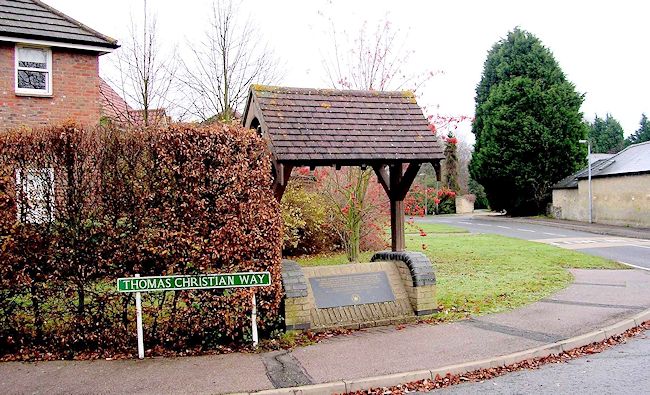 mahawks, then the unmistakable
din of the P-47, followed by the continual sound of a full strength formation of
four Mustang escort fighters of 361st.
mahawks, then the unmistakable
din of the P-47, followed by the continual sound of a full strength formation of
four Mustang escort fighters of 361st.
Col. J J. Christian was
the Group Commanding Officer for the period from 10th
February 1943 to 12th August 1944.
Lou the IV, the Mustang he flew in carried the serial number 413410. Col.
Christian was killed on the 12th of
August 1944 in a crash of his P-51D, missing with three other 361st
Group Mustangs. At Bottisham there is a new plaque put on site in the old
command buildings when the new housing estate was built.
| THE BUILDS |
JJ.Christian Mustang ‘Lou the IV’ s.n. 413410
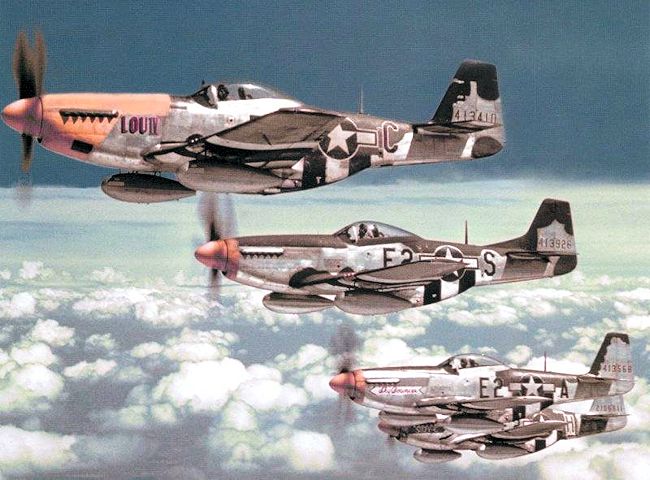 Noteworthy of the Airfix
kit was the embossed moulded side panels detail, this proved quite effective.
The exhaust stacks were produced as separate pieces and were large enough to
permit drilling open the outlets. The radio rack aft of the seat is well
produced but the cockpit canopy was somewhat thick in section, which made
interior detail less visible. The wheel well and inner doors were painted zinc
chromate. The perspex cockpit had been drilled to allow a fine line aerial to
pass through and fix to the tail fin. The tail fin had to be modified at its
root. This was cut so that the tail fin went in a straight line to the fuselage
as shown in side views, which differed, from the other two Mustangs. With all
these few additional detail the Mustang made into a pleasing model although it
is too shallow in nose area. The kit was given the overall aluminium finish.
This was applied with an airbrush however the ideal sheen was produced by adding
a few drops of gloss white and more drops of semi matt varnish and all mixed
together prior to airbrushing onto the kit. Two coats were applied with time to
dry and a smooth wet and dry sanding in between. Now comes the controversy about
the upper surface camouflage colour that was applied to a number of the 361st
group Mustangs including the Lou IV.
Noteworthy of the Airfix
kit was the embossed moulded side panels detail, this proved quite effective.
The exhaust stacks were produced as separate pieces and were large enough to
permit drilling open the outlets. The radio rack aft of the seat is well
produced but the cockpit canopy was somewhat thick in section, which made
interior detail less visible. The wheel well and inner doors were painted zinc
chromate. The perspex cockpit had been drilled to allow a fine line aerial to
pass through and fix to the tail fin. The tail fin had to be modified at its
root. This was cut so that the tail fin went in a straight line to the fuselage
as shown in side views, which differed, from the other two Mustangs. With all
these few additional detail the Mustang made into a pleasing model although it
is too shallow in nose area. The kit was given the overall aluminium finish.
This was applied with an airbrush however the ideal sheen was produced by adding
a few drops of gloss white and more drops of semi matt varnish and all mixed
together prior to airbrushing onto the kit. Two coats were applied with time to
dry and a smooth wet and dry sanding in between. Now comes the controversy about
the upper surface camouflage colour that was applied to a number of the 361st
group Mustangs including the Lou IV.
The dark/blue green could easily look blue to the
untrained observer however knowledgeable he would have been in those days. So
the question remained whether the upper camouflage was blue or green as appl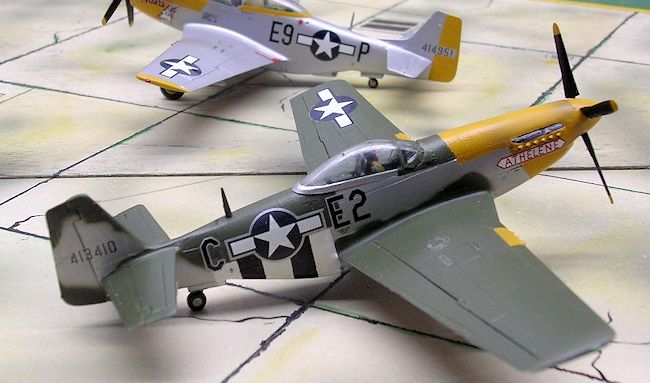 ied
to this particular fighter group during the summer of 1944.This is an issue
frequently rose among modellers, but the recent colour detail release by
Aeromaster shows this to be olive drab. The controversy continued to swirl
particularly around the Mustang flown By JJ Christian, being the most colourful
in the group at one time. The controversy was ongoing for some time and became
more prominent when a restored Mustang owner in America finished his Lou IV
replica in Royal Blue scheme while another one painted his in a darker shade of
blue! However it has been derived more recently that Urban Drew, who is a
leading ace of 361 and one of the pilots in the 4 ship formation often seen in
aviation books stated that the Mustang of the group were painted olive drab on
their upper surfaces. Other serving members of the group agree with this while
one of the well-known aviation historians Michael JF Bowyer stated clearly that
he had seen the aircraft and they were painted blue. So there remains an ongoing
argument that in my opinion depended on the sky conditions and therefore for
some the matter remains indecisive.
ied
to this particular fighter group during the summer of 1944.This is an issue
frequently rose among modellers, but the recent colour detail release by
Aeromaster shows this to be olive drab. The controversy continued to swirl
particularly around the Mustang flown By JJ Christian, being the most colourful
in the group at one time. The controversy was ongoing for some time and became
more prominent when a restored Mustang owner in America finished his Lou IV
replica in Royal Blue scheme while another one painted his in a darker shade of
blue! However it has been derived more recently that Urban Drew, who is a
leading ace of 361 and one of the pilots in the 4 ship formation often seen in
aviation books stated that the Mustang of the group were painted olive drab on
their upper surfaces. Other serving members of the group agree with this while
one of the well-known aviation historians Michael JF Bowyer stated clearly that
he had seen the aircraft and they were painted blue. So there remains an ongoing
argument that in my opinion depended on the sky conditions and therefore for
some the matter remains indecisive.
Captain Walter J. Kozicki Mustang ‘Pegasis’ s.n.414951
scale model
For the model of the ‘Pegasis’
I used a kit by Hasegawa which was acquired way back in the mid 70s and only
recently arrived it’s turn to be built with the arrival of the Yellow nose
Mustang decal sheet by Aero Master. The kit is moulded in silver plastic and
includes two cockpit canopies, which are the early more
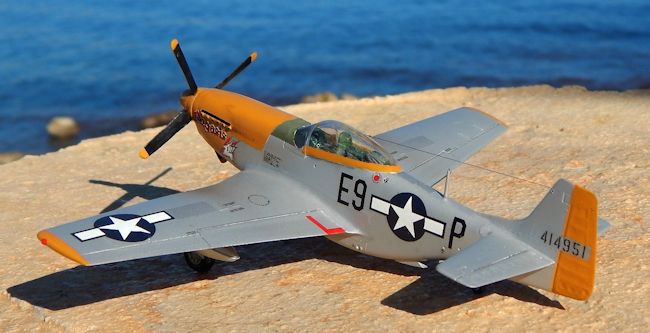 curved type or the other
that has a notch over the front section. The kit was neatly moulded with
slightly raised panel lines and included a detailed decal sheet incorporating an
instrument panel and propeller blade markings. I found the construction of the
kit rather straightforward. Prior to closing the fuselage halves I have painted
the interior light cockpit green and it is left up to you to add an acceptable
amount of interior detail to sidewalls mainly in form of paintwork over the
detail already present, as the space is limited. Some filler was also need in
way of joint. There are the exhaust doors under the fuselage, which are moulded,
in the open configuration. These need some cleaning with a sharp modeling knife.
There is a separate nose part that is a little too proud when fitted in place
and this was sanded as required. The exhaust stabs are moulded as part of the
fuselage and appeared under scale and too small to allow drilling to open the
outlet of each stab as was possible on the Airfix model.
curved type or the other
that has a notch over the front section. The kit was neatly moulded with
slightly raised panel lines and included a detailed decal sheet incorporating an
instrument panel and propeller blade markings. I found the construction of the
kit rather straightforward. Prior to closing the fuselage halves I have painted
the interior light cockpit green and it is left up to you to add an acceptable
amount of interior detail to sidewalls mainly in form of paintwork over the
detail already present, as the space is limited. Some filler was also need in
way of joint. There are the exhaust doors under the fuselage, which are moulded,
in the open configuration. These need some cleaning with a sharp modeling knife.
There is a separate nose part that is a little too proud when fitted in place
and this was sanded as required. The exhaust stabs are moulded as part of the
fuselage and appeared under scale and too small to allow drilling to open the
outlet of each stab as was possible on the Airfix model.
Upon joining the wing
parts together these had the interior of the wheel wells quite detailed but the
tail wheel well was too deep to allow detail in this area. The under wing
radiator also needed some filler as well as to the front wing root area. The
centre undercarriage doors can be left closed even with the
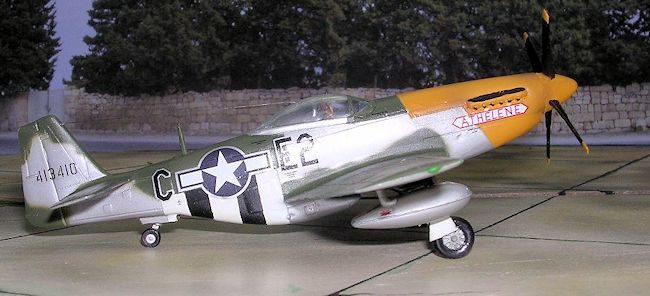 undercarriage in the
down position as many pictures would show it.. These had tendency to drop down
as the hydraulic pressure to its actuators is lost. One has to choose to glue
the bombs or the drop tanks both of which were carried by the 361st
group Mustangs. The radio antenna was replaced with a flattened metal pin and
filed to the correct shape and size and a wireless was added in same way as I
did with the other Mustang kit. All the extra detail added to the kit made it
all the more look like the allied fighter that had a range and speed to be able
to escort bombers to all their targets and still be able to hold off attacking
fighters, which was the P-51D.
undercarriage in the
down position as many pictures would show it.. These had tendency to drop down
as the hydraulic pressure to its actuators is lost. One has to choose to glue
the bombs or the drop tanks both of which were carried by the 361st
group Mustangs. The radio antenna was replaced with a flattened metal pin and
filed to the correct shape and size and a wireless was added in same way as I
did with the other Mustang kit. All the extra detail added to the kit made it
all the more look like the allied fighter that had a range and speed to be able
to escort bombers to all their targets and still be able to hold off attacking
fighters, which was the P-51D.
| COLORS & MARKINGS |
Aero Master Products
released decal sheets of Yellow nose Mustangs of the 361st
Fighter Group before the company was sold. This was a number of years back and
the new owners have not released any new sheets. Sheet 72-208 covers three
Mustangs to a scale of 1/72 and contained all the markings for the Bottisham
based fighters. The Mustangs represented in this set are; P-51D ‘Gay Crusader'
flown by Lt Homer G.Power; P-51D 'Pegasus' flown by Capt. Walter J. Kozicki; and
P-51D 'Lou IV' flown by Thomas
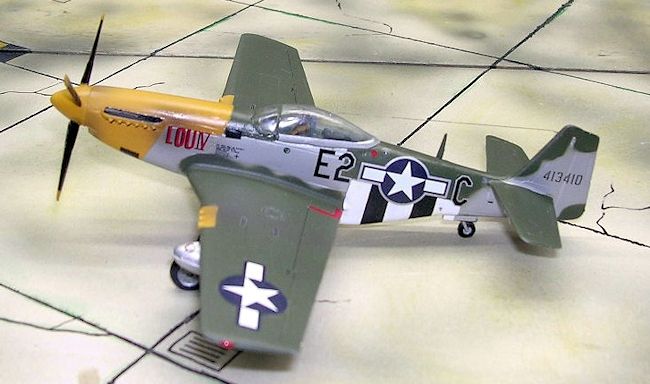 JJ. Christian. Gay Crusader and Pegasis are both
basically silver overall with yellow nose, rudder and wing tips. Gay Crusader
carried black anti glare section in front and all black canopy framing. Lt.
Homer Power scored three aerial victories. Interesting about this P-51 is that
there is a bottom black bar to the fuselage P code that denotes that another
aircraft in the squadron carried that code. The second aircraft Pegasis had a
final tally of 2 aerial victories and 1 probable and 1 damaged. This was one of
the subjects represented on one of my Mustang models.
JJ. Christian. Gay Crusader and Pegasis are both
basically silver overall with yellow nose, rudder and wing tips. Gay Crusader
carried black anti glare section in front and all black canopy framing. Lt.
Homer Power scored three aerial victories. Interesting about this P-51 is that
there is a bottom black bar to the fuselage P code that denotes that another
aircraft in the squadron carried that code. The second aircraft Pegasis had a
final tally of 2 aerial victories and 1 probable and 1 damaged. This was one of
the subjects represented on one of my Mustang models.
The third P-51D is Lou the IV and this happened to be one of the most controversial of all the Mustangs. . Often depicted in medium blue camouflage in place of the olive drab upper camouflage this has become the source of heated debate. The aircraft was flown by Thomas JJ Christian. It is natural metal finish with olive drab anti glare panel. Upper surface of wings and horizontal stabilizers and rear of fuselage over painted with olive drab. I.D. Invasion stripes were applied to bottom of wings and fuselage. Lou IV in red appears on the port side of nose and Athlene in red over a white background appears on the starboard side of an otherwise yellow painted nose.
| REFERENCES |
‘The Mighty Eight.’ A
history of the US 8th Army Air
Force by Roger A. Freeman
‘Action Stations’ No1. Military airfields in East Anglia by Michael J.F Bowyer
July 2015
Thanks to for the preview kit. You can find this kit at your favorite hobby shop or on-line retailer.
If you would like your product reviewed fairly and fairly quickly, please contact the editor or see other details in the Note to Contributors.